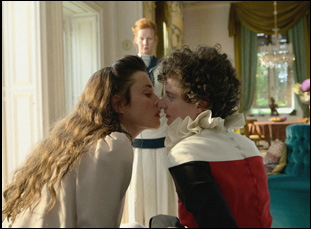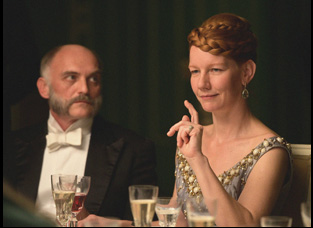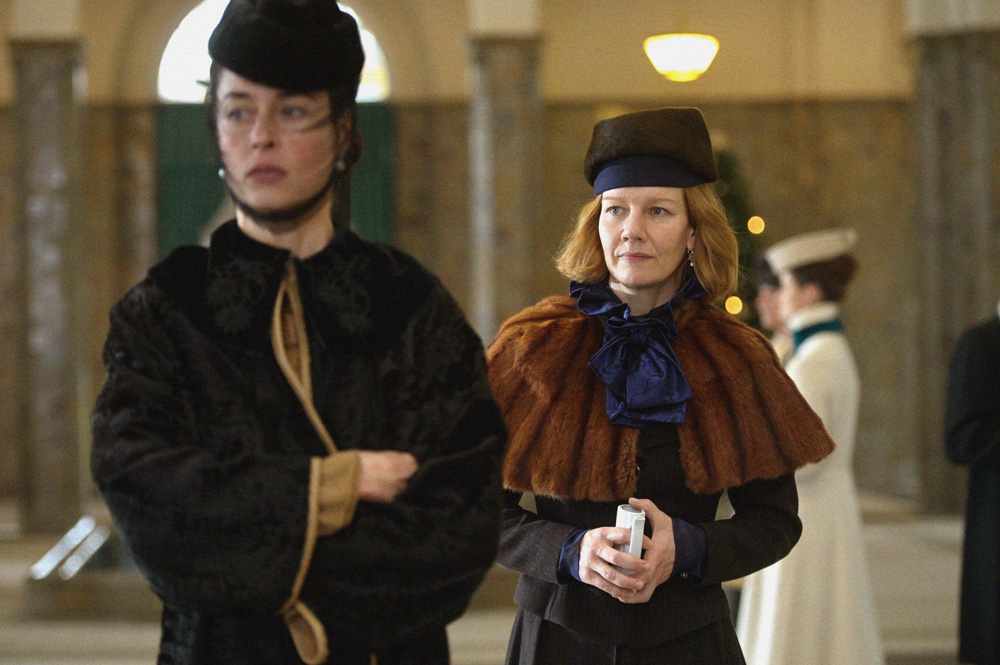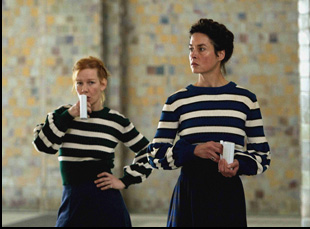Before making “Sisi and I,” Frauke Finsterwalder didn’t have especially fond memories of the legendary Empress of Austria who became Queen of Hungary after marrying Franz Joseph, mythologized largely in the 1950s films that were a Christmas staple all across Europe starring Romy Schneider.
“I never really liked them because I wasn’t really into princesses and things like that as a child,” says Finsterwalder, who surely was onto something even at a young age when Schneider, the actress who starred in those films as a teen, would play a far more sophisticated version in middle age as a part of Luchino Visconti’s “Ludwig.” “I probably liked them because my mom enjoyed watching them, but [this film] wasn’t really influenced by that. I think I was much more influenced by Visconti and the female characters that he had in his films, especially in ‘Conversation Piece.’”
If “Sisi and I” is rooted in anything, it’s that when Finsterwalder proudly declined to do more than give cursory glances at the Empress’ biography for her enchanting drama, which takes the shrewd perspective of seeing the pampered Empress (Susanne Wolff) through the eyes of Irma (Sandra Hüller), a countess urged on by her mother to take the position of a lady-in-waiting in her court. While Irma sees the Sisi regal in a different respect than most in time when most women were bound in corsets and beholden to what the men around them would think when she’s able to follow her muse wherever that may lead — though she is capable of being as fickle and casually cruel as she is fun and free-spirited —Finsterwalder recasts one of the intriguing periods of the Empress’ life by spending time in Corfu, where it was true that Sisi lived without the company of her husband, who galavanted around the world while she was able to create her own private haven, surrounding herself with other women free of the male gaze.
Irma comes to greatly admire Sisi in this context, but Finsterwalder observes something more tragic when the Empress can only rule the world of her own making for so long and like Marie Kreutzer’s 2022 drama “Corsage,” which reenvisioned the Empress as a rebel in taking a longer view of her life, “Sisi and I” seems all the more poignant because the director is able to show, even after her death, that storytelling has been a way to confine her to a certain image that was yet another prison she sought to escape. Driven by the type energy needed to break through, “Sisi and I” may have an additional verve when it is Finsterwalder’s long-awaited follow-up to her inventive 2013 ensemble drama “Finsterworld,” which featured then-rising stars Huller and “Wetlands” breakout Carla Juri, and on the eve of the film’s release in the U.S. after a premiere at Berlinale last year, the director spoke about making a triumphant return to the big screen, creating such a colorful portrait of a woman long reduced to black-and-white and formally defying conventions within the film itself.
It actually came about because of Sandra [Huller] because I had worked with her on the previous film, and we were in touch over the years. She had a smaller role in my previous film and we always said, “Hey, we want to do like a big film together,” so then I stumbled across the diary of one of Empress Sisi’s ladies-in-waiting and I read about another side of her that I didn’t know historically. She was actually quite fun to be with and quite cruel at the same time, and these ladies-in-waiting were all absolutely in love with her, so I decided, the lady in waiting would be a great part for Sandra and that’s how that started.
Susanne Wolff is also quite good as Sisi. What was it like to pair them?
Yeah, I’d written the part for Sandra, but then I really didn’t know who could be the Empress because Sandra is such an incredible actress that it was clear it had to be someone that she would be fascinated by as a person in order to pull this off — it’s like a love story of someone falling for someone, and it had to be someone quite powerful in her physical presence. The casting agent mentioned Susanne and I didn’t really know her because she’s mainly a stage actress, but I called Sandra and I said, “Hey, what about Susanne Wolf?” And she said, “Wow, Susanne Wolf.” The two of them share the same agency, so I think they had seen each other at parties, but they had never talked to each other and I think in some ways she was in awe of Susanne from afar [which] I knew was good. When I invited Susanne and Sandra together for a combination casting, Susanne entered the room and Sandra really was in awe.
But that’s only one part of the story because in the film they’re actually behaving like girls, having fun together. They giggle, they laugh, and they’re quite hysterical and cheeky and I didn’t know if that lighter part of this would work. There’s a scene in the film where both of them take hashish and have these kind of incredible laugh attacks, so we did that in the casting just to see if they could be funny together as well and they were rolling on the floor and it was really fun. I had to laugh myself, just watching them and it was clear that Susanne was the right person for the role.
Another key piece of casting is this amazing house you find as Siri’s lair. How did you end up with this location?
There’s an original house that the Empress built in Corfu, but my feeling is that Sisi did not have the best of taste, so that house is not very nice and it doesn’t tell the story of the woman that I wanted to tell, which is a woman who was quite free-spirited and fun. That house has been renovated over the years, but it’s even worse now, so I decided it had to be a house that’s incredibly beautiful and warm and tells the story of someone who’s actually living there with this commune of women.
We ended up looking for a location where we could shoot that part, but also the parts that take place in Northern Africa and Algiers. That’s how we came to Malta, which is an island in the Mediterranean where a lot of Hollywood films are being made, and we found the house that was absolutely perfect. And we shot in five different countries — parts of the interiors of that house were shot in Bavaria and Vienna, Austria, and [we] found different places because that specific house was not so nice from the inside, but the gardens and the outside were stunning.

It’s a bit of a road movie. They travel to a lot of countries and places within the film, so there were certain colors that we associated with certain places and traditionally Sisi always wears black and I didn’t want that at all. I wanted more colors. Corfu [had] very warm colors and when they move into the desert, it’s getting really yellow and orange, but when [Sisi] then goes back to Hungary and to the court, that’s when she starts to wear dark dresses, which are the ones that we would know her from paparazzi photos in the last weeks before she died. So I decided that when she’s going back to the world that she really doesn’t like, she’s going to wear what we would expect her to wear and also more narrow forms because in Corfu everything’s more free-flowing. I didn’t want corsets because I wanted to show someone that is not wearing them. It’s quite free and it was very clear what we wanted to have and which place.
Then when we first see Irma, Sandra Hüller’s character, she wears this really poofy pink dress and I remember writing into the screenplay the mother and Irma looked like Cinderella and her stepsisters, so we tried to make them really over the top, baroque costumes that would not have been worn in that period. Pink was one of the things that I wanted in there. The rooms where the first scenes take place were pink and it was a very close relationship between the costume designer Tanja Hausner and the set designer Katharina Wöppermann, who have worked together a lot, so every costume was made for a certain room and a certain color scheme.
From what I understand, the costumes were actually influenced in part by your ideas for the soundtrack, which seems like it must’ve been pretty foundational generally, but I wonder how those elements connected.
Yeah, that’s how I work normally. I hear a song and then I start writing a scene or a character. It’s always influenced by music. The Portishead song that we hear at the beginning of the film was something that came on on the radio and I was like, “That’s actually the story of Sisi and Irma,” and I didn’t know then that I was going to actually use it in the film, but I started to think about these women that are very confident, modern, free, and fun. Then I looked at the costumes of the time, which were Victorian dresses from the 19th century, and they’re terrible. They tell a completely different story. That’s where Visconti and these Italian designers from the ‘60s and ‘70s came into place. I decided to use those shapes and those kinds of dresses for the women and also, for example, [the idea] for the women to ride in trousers. We’ve seen this image of the beautiful princess and the floating dress and the horse so many times in films, I wanted it to be more hands-on and practical and fun so that we would take them seriously.
Also because we created these costumes that could actually be worn and that you could move in, that also influenced how people are sitting in the film because that was one of the rules — they were not allowed to ever sit straight. There was only one scene where [the actors] were allowed to do that. That’s when the nasty mothers come for supper. But in the rest of the film, they were supposed just to hang out and often they lie on sofas or on top of each other. And it’s quite natural for people that are in a safe space and how would be with each other, so everything influenced everything. In the end, because I had this playlist, which I always have and I normally play to actors when we shoot a scene, I decided why not use it as the soundtrack because it somehow worked with the cinematic style.
Now I’m going to need to watch it all over again because I’m sure I felt the sitting rule subconsciously, but I didn’t realize it.
That’s good. You were not supposed to notice. But normally in period films, you have people who are sitting very stiffly and they drink from a cup of tea, sticking their pinky out. People are overly civilized, but you cannot be like that 24 hours a day and I’m showing people in their private space, so it was really important to not ever have that happen in the film. People are touching each other — someone is putting their head on someone’s shoulder or hugging and there’s all this stuff going on because it’s so natural, but [you’d expect that in a contemporary film and maybe not here.
Even though the story is completely fictional, there were things like the Ouija board that Sisi brings out that seems like it must’ve come from research. Were there interesting details you could mine from the time?
This is one of the things you have to imagine [about] aristocrats in the 19th century, hanging out in either their big houses or their friends’ big houses for days and days and this was one of the things that people just enjoyed doing. Sisi was very much into tarot cards and all of that, and I think she really believed in spirits. She loved ghost stories. But it was also something that people did — they would put on a play [where] you would dress up and there were no TVs or no radio, so it was a way of keeping everyone entertained. The Ouija board was part of that too, so it’s quite historically accurate.

Not so much for me. But of course, it was a huge discussion with the producers because animals are always time consuming and it’s an insurance thing. At some point, I got tired of discussing and said, “Okay, we will just have dogs whenever we can” and then I was talking to the handler of the animals, and I was joking, “There’s one more thing that I would like and that’s tortoises.” And he was like, “Oh my God, are you kidding me? No way.” But in the first location that we shot — the interiors of Corfu in Vienna, this is a house that belongs to an old family and I was chatting to the owner of the house, [who] was like, “Oh, do you want to see my tortoises? I have them in the garden. I’ve had them since I was three years old.” And this lady was 80, so these tortoises were extremely old. And I was like, “Would you mind if we use them for the film?” And she [said] “No problem,” so that’s how I got my tortoises.
These things started to happen, like coincidences. There’s a chameleon in the film that wasn’t planned. It was just there, so the camera assistant just filmed it, so I got a chameleon as well. And with the dogs, depending on the country where we were shooting, some of them didn’t really do what they promised they could do, so some scenes weren’t possible to shoot the way how I wanted them to be shot. But it was nice to have the animals and it was nice because I have a dog, and I wasn’t allowed to go home for almost a year during the shoot of the film because of COVID and all of that, so I was just so happy to have all these dogs [around].
You’ve said it was actually wanting to stay home to raise your family that contributed to the decade between this feature and your last one a decade ago. What was it like being back on set?
It felt really natural because I had a lot of people surrounding me that I had worked with before. The set designer was on my previous film, Sandra was on my previous film, and I’ve known the producers since film school and I’ve done all my films with them. It wasn’t really that intimidating. I was just so happy to be back. It was an incredibly smooth shoot from the beginning on and I knew since I was six that I wanted to be a director, so it just felt like natural and what I love doing. And [getting it out into the world] is the best part. I went to a lot of screenings and did a lot of Q and A’s, which I love because it’s really nice to also see how an audience reacts — the people that are just the people we make these films for. I lived in the States for five years, so it’s especially nice that the film is coming out [there] and actually in my favorite cinemas that I used to go to when I lived there, so it’s all been great.
“Sisi and I” opens on July 12th in New York at the Quad Cinema and Coral Gables at the Coral Gables Art Cinema, July 19th in Los Angeles at the Monica Film Center and San Diego at the Digital Gym Cinema, July 26th in Tuscon at the Loft Cinema, August 2nd in Chicago at the Gene Siskel Film Center, August 9th in Cincinnati at the Mariemont Theater.





